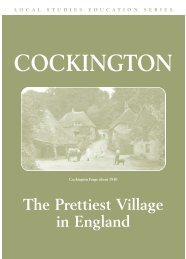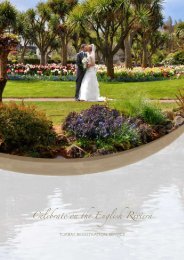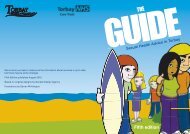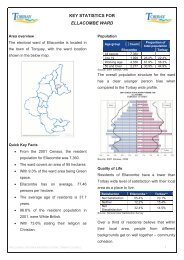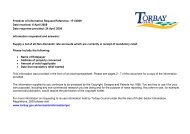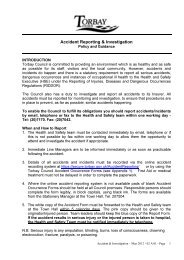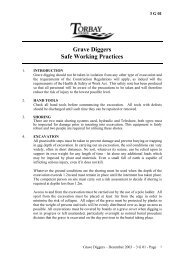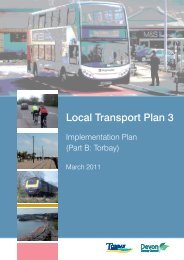Watcombe Park Conservation Area Character ... - Torbay Council
Watcombe Park Conservation Area Character ... - Torbay Council
Watcombe Park Conservation Area Character ... - Torbay Council
- No tags were found...
You also want an ePaper? Increase the reach of your titles
YUMPU automatically turns print PDFs into web optimized ePapers that Google loves.
6.1 Brunel Woods form the focal point of the main landscape features within theconservation area, about half of which consists of tree cover. An information boardwithin the wood outlines the history of the park, its richness and variety of vegetation.It records the thousands of cartloads of peat that were brought in to assist in theplanting of an arboretum, with many species of conifer introduced, for example theMonterey Cypress (Cupressa macrocarpa), which at the time was a rarity. The part ofthe park dedicated to the public suffered neglect between Brunel’s death in 1859right up until 1987 when a local trust was formed to research and protect Brunel’sachievement: plotting all the trees just before a major storm of 1990. This became avaluable record when Task Force Trees (jointly operated by <strong>Torbay</strong> <strong>Council</strong> and thethen Countryside Commission) carried out major landscape restoration. The BrunelColumn and the associated sculptures surrounding it, using storm damaged timber,were completed in 1993 by Keith Barrett and record aspects of Brunel’s life andwork.6.2 In spite of the storm many of the original trees survived and there are some goodexamples of Mediterranean pine and especially Monterey pine (Pinus radiata). Alsopresent are holm oak (quercus ilex), Spanish oak (quercus x hispanica) and whatappears to be one or more specimens of the locally found Lucombe Oak(LUCOMBEANA). There are also many of the more common deciduous species, forexample oak (quercus robur), ash (fraxinus excelsior), lime (tilia x europaea),sycamore (acer pseudoplatanus), beech (fagus sylvatica), and horse chestnut (aesculushippocastanum). Clearly the original concept was thematic and separate parts of thepark are identified as the thornery, beech wood, pinetum, the avenues, the quarry,Brunel’s Rockery, and the meadow.6.3 Dense woodland also exists to the east of Teignmouth Road and north of <strong>Watcombe</strong>Beach Road, but apart from a single footpath from the public car park it is largelyinaccessible. Otherwise landscape features fall into two main categories. Firstly thereare hedges and hedgerow trees bordering parts of Moor Lane, Steps Lane,Teignmouth and <strong>Watcombe</strong> Beach Roads. Secondly are mature trees either within orbordering the grounds of the villas with a few fine specimen trees surrounded bylawns. Almost everywhere, trees act as a foil or a backdrop to buildings, even in thecase of recent development, and in some cases obscuring them almost completely.6.4 Between <strong>Watcombe</strong> Lodge and <strong>Watcombe</strong> House the rough land is the result of claypit diggings. G F Allen, who had bought <strong>Watcombe</strong> House in 1857 to retire to,discovered a rich vein of potters’ clay here during 1867 while digging for a wellduring landscaping. He establsihed the <strong>Watcombe</strong> Terrac-Cotta Clay Company ½mile away in St Marychurch to exploit it.7 THE SETTING AND FEATURES OF SPECIAL IMPORTANCE7.1 <strong>Watcombe</strong> complete absence from the historical record – early 19 th century mapsrecord it as open countryside – comes to an end with the construction of theTeignmouth-Torquay turnpike following the opening of the Shaldon bridge in 1827,and Torquay’s development as a fashionable resort. The scattering of villas begin to10<strong>Watcombe</strong> <strong>Park</strong> <strong>Conservation</strong> <strong>Area</strong> <strong>Character</strong> Appraisal adopted 2 August 2005



